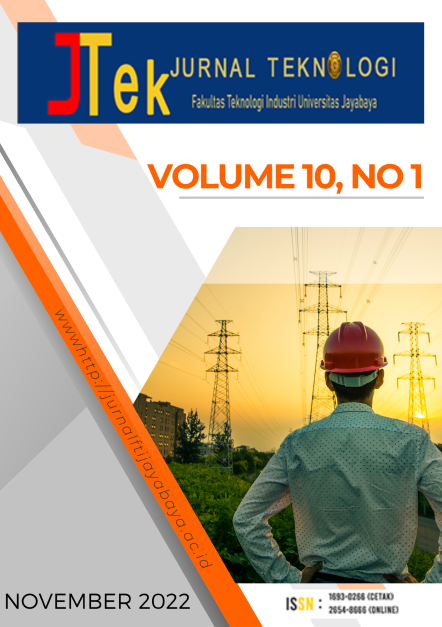Pengaruh Waktu Aging pada Pembuatan Nano Particle Geothermal Silica (NPGS)
DOI:
https://doi.org/10.31479/jtek.v10i1.199Keywords:
nanosilica, geothermal, aging time, sol-presipitasiAbstract
Pembangkit Listrik Tenaga Panas Bumi (PLTP) Dieng menghasilkan lumpur geothermal (silica scaling) yang kandungan terbesarnya adalah silika. Silica scaling tersebut akan menjadi bahan baku natrium silikat. Natrium silikat tersebut selanjutnya digunakan untuk membuat nanosilika. Tujuan penelitian ini adalah untuk mengetahui pengaruh waktu aging terhadap ukuran partikel pada pembuatan nanosilika. Metode yang digunakan untuk mensintesis nanosilika yaitu metode sol-presipitasi. Penelitian diawali dengan membuat larutan natrium silikat primer dan sekunder dan dilanjutkan pengasaman dengan asam sulfat. Kemudian dilakukan tahap aging dengan variasi waktu aging terhadap campuran yang terbentuk. Nanosilika yang dihasilkan pada penelitian ini dikarakterisasi menggunakan FTIR dan TEM. Hasil karakterisasi FTIR nanosilika menunjukkan adanya gugus siloksan (Si-O-Si). Hasil karakterisasi TEM nano partikel dengan waktu aging 1 hari, 3 hari dan 5 hari yaitu 19,31 nm; 19,67 nm dan 19,75 nm berturut-turut.Downloads
References
R. Wahyudityo, A. W. Harto, and K. Suryopratomo, “Analisis Scaling Silika pada Pipa Injeksi Brine di Lapangan Panas Bumi Dieng dengan Studi Kasus di PT. Geo Dipa Energi,” Teknofisika, vol. 2, no. 1, pp. 7–14, Jan. 2013.
Silviana et al., “Natural Silica of Solid Waste From Geothermal Drilling in Dieng as Silica Gel through Environmentally Benign Processing,” Semin. Nas. Teknol. Ind. Hijau 2, vol. 1, no. 1, pp. 341–346, 2017.
J. G. Hooley, “The Kinetics of The Reaction if Silica with Group I Hydroxides,” Can J Chem, vol. 39, pp. 1221–1230, 1961, doi: 10.1139/v61-155.
A. Azhari and M. Aziz, “Synthesis and Characterization of Porous Material Based on the Belitung-Island Silica Mineral,” J. Teknol. Miner. Dan Batubara, vol. 12, no. 3, pp. 161–170, Sep. 2016, doi: 10.30556/jtmb.Vol12.No3.2016.135.
G. Budiharti, “Synthesis Of Silica Nanoparticles With Sol-Gel Method,” J. Inov. Fis. Indones., vol. 4, no. 3, pp. 22–25, 2015.
H. Hasri, M. Muharram, and F. Nadwi, “A Synthesis Nanosilica of Bamboo’s Leaf (Bambusa sp.) by Using Hydrothermal Method,” J. Kartika Kim., vol. 3, no. 2, pp. 96–100, Nov. 2020, doi: 10.26874/jkk.v3i2.56.
V. J. Mohanraj and Y. Chen, “Nanoparticles - A review,” Trop. J. Pharm. Res., vol. 5, no. 1, pp. 561–573, Jul. 2007, doi: 10.4314/tjpr.v5i1.14634.
N. S. Indrasti, A. Ismayana, A. Maddu, and S. S. Utomo, “Synthesis of Nano-silica from Boiler Ash in the Sugar Cane Industry using the Precipitation Method,” Int. J. Technol., vol. 11, no. 2, p. 422, Apr. 2020, doi: 10.14716/ijtech.v11i2.1741.
F. Delvia and S. Aini, “Pengaruh Waktu Aging Terhadap Kristalinitas dan Ukuran Partikel Silika Mesopori,” vol. 9, no. 2, p. 3, 2020.
I. A. M. Ibrahim, A. A. F. Zikry, and M. A. Sharaf, “Preparation of spherical silica nanoparticles: Stober silica,” J. Am. Sci., vol. 6, no. 11, pp. 985–989, 2010.
F. D. M. Daud, M. H. Johari, A. H. A. Jamal, N. A. Z. Kahlib, and A. L. Hairin, “Preparation of nano-silica powder from silica sand via sol-precipitation method,” in AIP Conference Proceedings, Kelantan, Malaysia, 2019, vol. 2068, pp. 020002-1-020002–4. doi: 10.1063/1.5089301.
W. K. Setiawan, N. S. Idrasti, and Suprihatin, “Synthesis and characterization of nanosilica from boiler ash with co-precipitation method,” in 2015 3rd International Conference on Adaptive and Intelligent Agroindustry (ICAIA), Bogor, Aug. 2015, pp. 160–164.
M. Munasir, T. Triwikantoro, M. Zainuri, and D. Darminto, “Ekstraksi dan Sintesis Nanosilika Berbasis Pasir Bancar dengan Metode Basah,” J. Penelit. Fis. Dan Apl. JPFA, vol. 3, no. 2, p. 12, Dec. 2013, doi: 10.26740/jpfa.v3n2.p12-17.
S. Musić, N. Filipović-Vinceković, and L. Sekovanić, “Precipitation of amorphous SiO2 particles and their properties,” Braz. J. Chem. Eng., vol. 28, no. 1, pp. 89–94, Mar. 2011, doi: 10.1590/S0104-66322011000100011.
I. M. Joni, Rukiah, and C. Panatarani, “Synthesis of silica particles by precipitation method of sodium silicate: Effect of temperature, pH and mixing technique,” Bikaner, India, 2020, p. 080018. doi: 10.1063/5.0003074.
Muh. W. Sya’bani, Y. Suwarno, M. F. Agustian, I. Perdana, and Rochmadi, “Studies of geothermal silica as rubbers compounds reinforcing filler,” Surakarta, Indonesia, 2020, p. 030144. doi: 10.1063/5.0000730.
G. Sudhakaran and S. A. Avirah, “Studies on reinforcing effect of industrial nano silica in chloroprene vulcanizates containing carboxy-terminated liquid natural rubber,” J. Elastomers Plast., vol. 54, no. 3, pp. 509–517, Apr. 2022, doi: 10.1177/00952443211063597.
Y. Chen, Z. Peng, L. X. Kong, M. F. Huang, and P. W. Li, “Natural
rubber nanocomposite reinforced with nano silica,” Polym. Eng. Sci., vol. 48, no. 9, pp. 1674–1677, Sep. 2008, doi: 10.1002/pen.20997.
M. W. Syabani, R. Rochmadi, I. Perdana, and A. Prasetya, “FTIR study on nano-silica synthesized from geothermal sludge,” Kuala Lumpur, Malaysia, 2022, p. 030014. doi: 10.1063/5.0075015.
Downloads
Published
Issue
Section
License
The rights of publication and use of intellectual works in this journal are the full property of the publisher, while the moral rights belong to the author.
The formal legal aspects of access and utilization of each Journal of Technology articles are subjected to the Creative Commons Attribution-Share Alike (CC BY-SA) license, which means that journal content can be used freely and fairly (fair use) in a similar form even for commercial purposes.
To avoid malpractice and plagiarism in publication of article publishing, the author is asked to fill out and sign a copyright statement on the Declaration of Authenticity of the Manuscript and Copyright Transfer.






